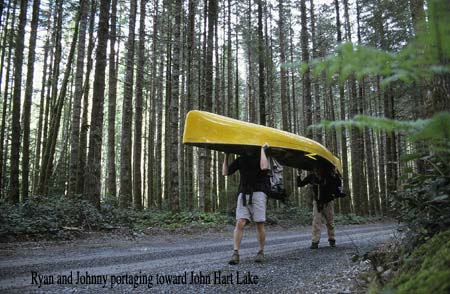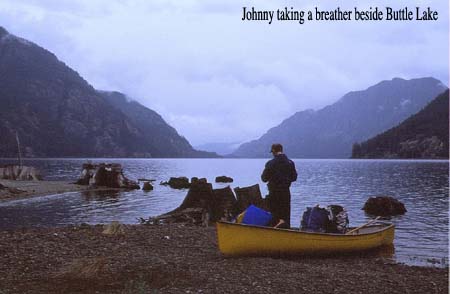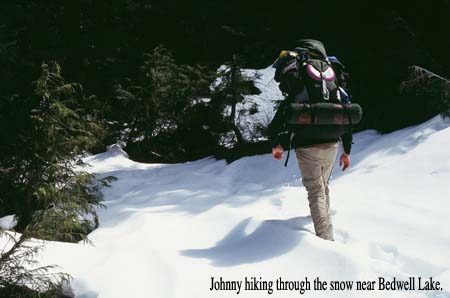Please visit Ryan Parton Writing Solutions, Comox Valley copy writer
 We'll Be Back
We'll Be Back
Young adventurers, thwarted by snow, vow return trip
By Ryan Parton
The Victoria Times Colonist, July 10, 2005
Our adventure began with a noble plan - to cross Vancouver Island entirely under our own power. Starting in Campbell River, we’d either paddle or carry a canoe across a series of four lakes, then hike across the mountains following the Bedwell River Valley to the west coast before hopping into sea kayaks for three days of paddling through a network of channels and inlets toward Tofino. If all went well, the 240-kilometre journey would take 10 days.
The expedition was the brainchild of my companion, John Histed. An avid outdoorsman whose mantra is “Seek out the hard way,” John can always be counted on to have some zany plan in the works, like throwing ourselves down some unknown river in a rubber dinghy or portaging a canoe five kilometres up General Hill, the daunting climb out of Campbell River along the Gold River Highway. But that was yet to come.
As we planned the trip our excitement was heightened by the fact that we hadn’t heard of anyone before who had crossed the island via the route we’d chosen. That excitement hit its apex when we finally dipped our canoe into the Campbell River estuary under a friendly grey sky and began our adventure.
The slight current at the mouth of the Campbell River quickly evolved into a rushing torrent of shallow water as we fought our way upstream. With John in the stern barking out orders in a frantic effort to keep ourselves facing forward, and myself desperately trying to find a path through the labyrinth of rocks just below the water’s turbulent surface, our progress was slowed to little more than a standstill despite both of us paddling beyond the limits of our aching shoulders.
 Although we’d planned to paddle for about a kilometre before beginning our first portage, we decided it would be easier to carry the canoe on dry land than continue our desperate uphill paddle. All-too-ready to flee the exhausting wrath of the current, we hauled our vessel ashore and, after a brief lunch of energy bars and trail mix, hoisted it over our heads and began to walk.
Although we’d planned to paddle for about a kilometre before beginning our first portage, we decided it would be easier to carry the canoe on dry land than continue our desperate uphill paddle. All-too-ready to flee the exhausting wrath of the current, we hauled our vessel ashore and, after a brief lunch of energy bars and trail mix, hoisted it over our heads and began to walk.
With the canoe’s seats resting atop our backpacks, we trudged along the paved shoulder of the Gold River Highway, belting out off-key Stompin’ Tom tunes to keep our minds off the growing burn in our legs. Although I was surprised that the sight of two men with full backpacks hauling a canoe along the side of the highway didn’t attract more attention from passing motorists, one old man standing alone on the side of the road for no discernible reason seemed utterly perplexed.
“Where are you going?” he shouted when we were close enough to hear.
“Tofino!” was John’s proud reply, and although I couldn't see him I knew that he was wearing a grin a mile wide, having wanted to say that since our trip began.
The man’s expression twisted into one of complete confusion. Finally, after carefully analyzing his mental map, he looked up and screamed, “You’re going the wrong way!”
Nearly two hours after our portage began, we finally arrived at the turnoff toward John Hart Lake, Campbell River’s water supply and our next paddling destination. There’s a certain romantic serenity in dipping your paddle into the glassy surface of a tranquil lake, such as John Hart was that day, with only the liquid rhythm of each stroke disturbing the silence. Gliding silently over the hulking stumps of what was once an extension of the forested shore, flooded in 1947 by the construction of the John Hart dam, I got the eerie feeling that we were paddling over a graveyard, each tomb preserved impeccably by the still water.
 Invigorated by the great outdoors, we made amazing time over John Hart until before we knew it we’d crossed the entire lake and had reached the Ladore Dam, which we bypassed by means of another quick portage. With the sun falling ever lower ahead of us, we were forced to find shelter on a narrow rocky beach on the edge of an ugly clear-cut. A Technicolor dusk over the lake and a gourmet dinner of teriyaki turkey, however, helped take our minds off the decaying tree-less wasteland behind our tent.
Invigorated by the great outdoors, we made amazing time over John Hart until before we knew it we’d crossed the entire lake and had reached the Ladore Dam, which we bypassed by means of another quick portage. With the sun falling ever lower ahead of us, we were forced to find shelter on a narrow rocky beach on the edge of an ugly clear-cut. A Technicolor dusk over the lake and a gourmet dinner of teriyaki turkey, however, helped take our minds off the decaying tree-less wasteland behind our tent.
The next day we paddled more than 30 kilometres across both Lower Campbell and Upper Campbell Lakes and discovered that a full day on the water can have strange effects on two men all alone in a canoe. Over the course of the day we tested a new mating call based on that of local frogs (“Boy! Boy!”); conversed with some chatty Canada geese (“mmmAAAWK!”); and temporarily became marauding pirates menacing anyone on shore until they were within earshot (“Gaar, yer women or yer lives!”) Sanity, like beauty, is often in the eyes of the beholder, and luckily for us there was rarely anyone else around.
Our third day of paddling began on the fickle-tempered Buttle Lake, a 32-kilometre long lake infamous for the southerly afternoon winds that can whip its surface into a dangerous froth of white caps. Almost as if on cue, the morning’s gentle headwind picked up just after lunch, sending nearly foot-high waves sloshing against our hull, although the wind soon mysteriously calmed and the lake became eerily glassy.
Though we had to selectively look at the forested hills hanging on either side of us to ignore the clear-cuts slashed seemingly at random into the thick green carpet, the landscape was not without its beauty. A thick mist hugged the hills and hazy, snowcapped crags loomed ahead in the distance, creating the impression that we really were paddling into the unknown.
We briefly celebrated our arrival at Buttle Lake’s southern terminus before bidding farewell to our faithful yellow canoe, and setting out on foot. Our hike began along the old Jim Mitchell mining road, a route littered with black bear scat that accesses the Bedwell Lake Trail, a well-maintained 6-kilometre path that ascends 600 metres as it winds toward Bedwell Lake.
 As we grunted along the trail’s steep switch backs, snow began to appear alongside the trail in sporadic clumps which gradually grew larger and deeper, until there was little bare earth to be seen. Trudging through the snow, at times falling through to our knees, our progress was painstakingly slow and the trail all but impossible to follow.
As we grunted along the trail’s steep switch backs, snow began to appear alongside the trail in sporadic clumps which gradually grew larger and deeper, until there was little bare earth to be seen. Trudging through the snow, at times falling through to our knees, our progress was painstakingly slow and the trail all but impossible to follow.
When we finally reached Bedwell Lake, it was decision time. We were worried about two potentially dangerous river crossings that lay ahead which we feared, judging by the amount of snow, would be impassable. Since we didn’t have enough to food to hike to the first river and then have to turn back, we were forced to make a difficult decision. We turned back.
The rugged wilderness with which we’ve been blessed here on Vancouver Island is no place to let pride get in the way of prudent decisions. To this day, John and I don’t know if those two rivers would have been passable, although we have no regrets over our decision. We’re also both determined that one day soon we’ll return to Bedwell Lake and complete our 240-kilometre journey to Tofino.

A Chronology of Decision-Making:
Feb. 2004: John Histed comes up with the idea of a human-powered traverse of Vancouver Island.
Feb. 2005: John and I decide to undertake the expedition in August, 2005, when water levels should be low.
Apr. 2005: Due to an unusual dearth of snow on Vancouver Island, we decide river levels should be sufficiently low and plan the expedition for May.
Apr. 27, 2005: After a heavy late April snowfall, we make arrangements to have snowshoes dropped off for us at the end of the canoeing leg of the trip.
May 4, 2005: Scanning the bare mountains that we’ll soon be hiking, we decide that snowshoes will be unnecessary and choose to leave them behind. An erroneous decision, we didn’t take into account the fact that we were looking at the mountains’ southern, generally less snow-covered, side.
May 5, 2005: Our progress slowed due to deep snow, we make arrangements by satellite phone to have our kayaks meet us on the west coast one day later than planned.
May 5, 2005: Judging by the amount of snow, we decided there was less than a 50 per cent chance that we’d be able to safely cross two rivers that lay ahead. Hiking a full day to the first river and then being forced to turn back would have put us dangerously short on food. Deciding it wasn’t worth the risk, we turned back.
Back to Ryan's writing samples
 Although we’d planned to paddle for about a kilometre before beginning our first portage, we decided it would be easier to carry the canoe on dry land than continue our desperate uphill paddle. All-too-ready to flee the exhausting wrath of the current, we hauled our vessel ashore and, after a brief lunch of energy bars and trail mix, hoisted it over our heads and began to walk.
Although we’d planned to paddle for about a kilometre before beginning our first portage, we decided it would be easier to carry the canoe on dry land than continue our desperate uphill paddle. All-too-ready to flee the exhausting wrath of the current, we hauled our vessel ashore and, after a brief lunch of energy bars and trail mix, hoisted it over our heads and began to walk. We'll Be Back
We'll Be Back Invigorated by the great outdoors, we made amazing time over John Hart until before we knew it we’d crossed the entire lake and had reached the Ladore Dam, which we bypassed by means of another quick portage. With the sun falling ever lower ahead of us, we were forced to find shelter on a narrow rocky beach on the edge of an ugly clear-cut. A Technicolor dusk over the lake and a gourmet dinner of teriyaki turkey, however, helped take our minds off the decaying tree-less wasteland behind our tent.
Invigorated by the great outdoors, we made amazing time over John Hart until before we knew it we’d crossed the entire lake and had reached the Ladore Dam, which we bypassed by means of another quick portage. With the sun falling ever lower ahead of us, we were forced to find shelter on a narrow rocky beach on the edge of an ugly clear-cut. A Technicolor dusk over the lake and a gourmet dinner of teriyaki turkey, however, helped take our minds off the decaying tree-less wasteland behind our tent. As we grunted along the trail’s steep switch backs, snow began to appear alongside the trail in sporadic clumps which gradually grew larger and deeper, until there was little bare earth to be seen. Trudging through the snow, at times falling through to our knees, our progress was painstakingly slow and the trail all but impossible to follow.
As we grunted along the trail’s steep switch backs, snow began to appear alongside the trail in sporadic clumps which gradually grew larger and deeper, until there was little bare earth to be seen. Trudging through the snow, at times falling through to our knees, our progress was painstakingly slow and the trail all but impossible to follow.